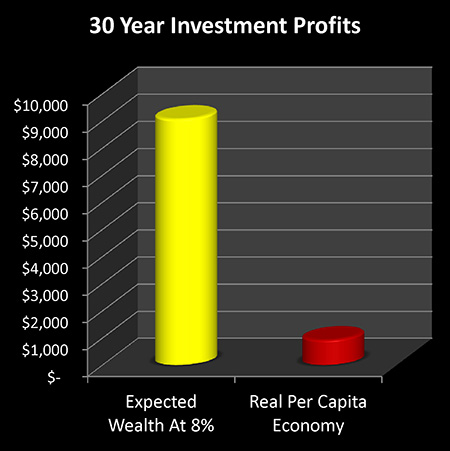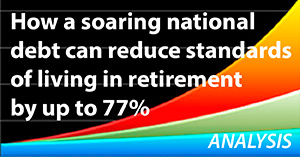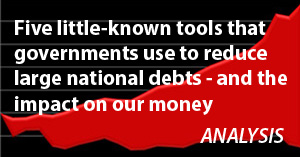Apple Pie, Economic Growth & Fatal Stock Market Flaws
By Daniel R. Amerman, CFA
What is it that will actually determine: 1) how our retirement investments will perform, 2) at what age we will be able to retire, and 3) what our standard of living in retirement will be?
For the usual answers, we've been taught to turn to the assumptions of conventional financial planning. But there's a problem with doing so, which is that the path that the economy and investments have actually taken over the last decade and more doesn't seem to have been anticipated in the usual assumptions.
What actually happened with the Financial Crisis of 2008 and the following Great Recession came as quite a surprise to many, as have the unusually low interest rates which are currently pushing back the planned retirement dates for many millions of people, even as these low rates reduce retirement standards of living.
In the interest of trying to avoid future surprises, perhaps we should start by asking some very common sense questions about retirement savings, that while absolutely essential – are rarely asked. Consider the following three:
1) Can the average person really become wealthier than the average person – or do things need to add up at some point?
2) Can an entire society create paper wealth at a far greater rate than the actual economic growth rate, and then simultaneously cash out this paper wealth into real goods and services?
3) If the economy is made up of corporations, individuals, and all levels of government – and the corporations and individuals, as well as state and local governments are all using investments to attempt to compound their wealth through the markets because neither the corporations, nor the individuals, nor the state and local governments can afford to pay for retirement promises and expectations without those investment sales – then who, precisely, is it that steps in and cashes their investments out? And with what?
On the rare occasions that these questions are asked, traditionally the answers might involve professional jargon, equations and an elaborate network of interlocking academic theories (which depend on simplifying assumptions and unproven hypotheses to a much greater extent than the general public realizes).
However, there is a simpler path.
As an analogy, consider a fresh, hot pie. Let’s call it an apple pie, though it could be blueberry or cherry if you prefer. Whatever the kind, that pie smells delicious, you are hungry, and you'd like a big, fat slice of it. The problem is, so do a lot of other people. How large of a piece can you get?
That depends on three things:
1) how big the pie is;
2) how many people also want a piece; and
3) whether some people are allowed larger portions than others.
Let’s liken that pie to the national economy. It's the United States economy that we'll be discussing here, but this can apply to pies of other nations as well.
Now the marvelous thing about economic pies is that in a growing economy they just keep getting bigger, year after year. And acquiring ourselves a big piece of that pie in the future is the motivation for investing of course. We all want as generous a portion of that expanding pie as we can get, and fortunately there are plenty of people willing to sell us future pieces of that pie.
Just how big is that succulent pie going to be? Various reasonable long-term rates of return for our investments are suggested depending on the source and investment type, but a nice one is 8%. Eight percent is a good number for example's sake, not just because it is nice and round, but it represents roughly what a particular type of calculation tells us is the long-term rate of return in the stock market.
So we take $1,000 today, invest it for 30 years, and with annual compounding (reinvestment of our earnings as we get them) that $1,000 sitting in a tax-deferred account soars to a total of $10,062, including our profit of $9,062. That is the amazing stuff of which financial planning is made!
The Economic Pie
Another approach is to look at the economic fundamentals of our pie. That is, buying investments essentially means that we are buying an ownership interest in the economy. When we buy shares of stock, we become owners of that corporation. Given that the economy is primarily made up of corporations, by collectively owning those shares of stock, we as investors effectively own much of the private economy.
Over the long term in the previous century (1950-2000), the United States economy grew at about 3.5% per year after removing the effects of inflation (source: Bureau of Economic Analysis). Of that about 1.2% a year can be accounted for by population growth (source: Census Bureau). Adjusted for inflation, then, we have real growth – per person – in the economy of about 2.2% a year. Now, take that same $1,000, and invest it for 30 years at a 2.2% rate, and it becomes worth… $1,921.
Uh, oh.
It seems like there might be a problem there. We buy investments expecting over 30 years to earn a 906% ($9,062) profit from our ownership interests in the economy. But after accounting for inflation and population growth, the overall per capita economic pie has only grown 92% ($921). So our expectations for growth in investment wealth are ten times larger than the growth in the real economy.

Pie Problems
I think you can see our pie problem, which is the difference between looking at the pie, and actually eating the pie. Around fifty million Baby Boomers are planning on eating generous slices of a really big investment pie at some point down the road. Not just all of the people who buy stocks and other investments directly, but also all of those who buy them through their retirement accounts, and indeed, anyone who is planning on getting a pension as part of their retirement.
So the issue is that when we add up all the different expectations for our future pieces of Investment Pie, and compare them to what in reality the total Economic Pie is likely to be – there just isn’t enough pie to go around.
Now an individual can certainly earn a particularly fat slice of the pie, so long as they follow an investment strategy that works out very well indeed. As some investors have in the past, and as others will in the future.
However, getting back to one of those fundamental questions: how can everybody earn those big slices simultaneously, as the conventional investment models indicate they will? How can one sixth of the entire population simultaneously have their real net worth increase 10 times faster (906/92) than the real per capita worth of the nation itself?
The amount of real wealth in terms of resources is growing far, far slower than people’s perceptions of their current and future wealth, as valued by their investment portfolios. And we have an enormous group of people planning on actually selling those investment portfolios to get real resources, simultaneously, year after year. How do we make it all add up?
The answer seems clear. Which is that they can earn that wealth on paper, but when it comes to real resources, it is unfortunately simply impossible for them to all to cash it out. Like a pie, an economy is made up of the sum of its slices. And when most of the people invested in that economy are all expecting their own slices to grow far faster than we know the overall pie is growing – an awful lot of people are likely to be very disappointed.
Historical Returns & Hypothetical Behavior
As long as we are asking questions, this is probably a good place to ask another: if an 8% investment return rate and 2.2% per capita economic growth rate are both based on long term history – what’s the problem? Obviously they can coexist, so why worry?
The issue is not whether stocks can earn an 8% paper yield while the economy is growing 2% on a real per-capita basis – so long as more people are putting money into the markets than are pulling it out. Because that can work just fine, as it has many years in the past.
The issue is all the people who looked at that 8% yield, and said, “Hey, we just found a magic money machine! All we have to do is assume 100% reinvestment of our investment earnings through our pensions, investment funds, IRAs and Keoghs, and all of society together can achieve financial security! And we can run models using hypothetical investor behavior to prove it historically!”.
(The particulars for the Magic Money Machine are explored in more detail here.)
If we take an equation with a high growth rate – and let it run wild with no constraints – then the math seems to prove that we all become wealthy, or at the least financially secure.
Keep going in time, and the same math necessarily also proves that our cumulative wealth will grow until it is larger than the universe itself.
Go still further out in time, and the mathematical equations will insist that each of our individual portfolios will grow until they are larger than the universe, too.
Uh oh.
See, that’s the usual problem with running exponential equations with no outside constraints, and is the reason these equations are used with great caution in fields other than finance, or subjects other than our collective life savings.
The issue with that approach – which underlies most long term investment planning today – is that the 10 to 1 figure isn’t so much based on historical earnings as it is the hypothetical compounding. All we’ve really done is demonstrate that exponential compounding is a powerful mathematical concept.
Unfortunately there are indeed constraints, and cashing out real goods and services requires a real economic pie. If we look at actual financial history, never before have we had so many people planning on eating such nice big slices of pie, and over such long retirements on top of that. In the past, life spans were generally shorter, and the ownership of securities was concentrated in a much smaller segment of the population.
We’ve made three big changes with our hypothetical investment models, which separate our current expectations from the historical yield analyses.
1) Never before have we had so many people – and such a large percentage of the population – investing in the markets .
2) Long term exponential compounding of our wealth had not previously been the objective – or the majority's behavior.
3) (And this is the most important part), never has such a large segment of society attempted to simultaneously convert such high compounded wealth expectations into real resources, for year after year, over a period of decades.
We have never before seen anything like this three way combination. Thus the ability of the markets to withstand this unprecedented test while delivering high rates of return is not based on history, but rather is unproven theory.
The Markets Save Everyone
Unproven theory notwithstanding, almost every level of government in the US that has full time employees has entered into promises for future benefits that the government anticipates being unable to fulfill from ongoing revenues.
Some of these promises are unfunded, while others are fully “funded” (meaning adequate current portfolios given the investment return assumptions), but the "solution" all comes down to the same thing. Via the mechanism of the markets, vast sums of money and resources will flow from the outside economy into the local economies for all the states and cities, and pay for the legally binding pension promises that would otherwise be unaffordable from current revenues.
Governments aren’t the only ones relying upon this compounding magic – so are most of the major corporations. Oh, the defined benefit plans have pretty much disappeared in terms of the ability of workers today to participate, but there are still tens of millions of workers covered, and many trillions of dollars of pension and health care benefits that will have to be paid. Future benefits that would destroy corporate profitability, and drive many corporations into bankruptcy.
If, that is, it weren’t for the Magic Money Wealth-Compounding Machine of the investment markets. With that market wealth providing the money to buy the goods and services for retired employees, that employers would otherwise not be able to pay.
Individuals are not left out of this game, far from it. That’s the whole idea of retirement plans, be they IRAs or Keoghs. You can put money in, but you can’t take it out before retirement, or at least you are strongly discouraged from doing so via tax penalties. So your money stays in and it compounds.
As demonstrated in the conventional financial planning models that have been run for many millions of individuals (example here), just take a modest amount of money every month, let historical rates of return compound forward, and you too can have a quite comfortable retirement. Along with the other 50 million Baby Boomers doing the same thing, as we all cash out together.
Simple Questions
This prompts the quite simple question that we started this exploration with.
If the economy is made up of corporations, individuals, and all levels of government – and the corporations and individuals, as well as state and local governments are all using investments to attempt to compound their wealth through the markets because neither the corporations, nor the individuals, nor the state and local governments can afford to pay for retirement promises and expectations without those investment sales – then who, precisely, is it that steps in and cashes their investments out? And with what?
If all the components of the economy can’t afford to pay for something from current revenues, then how do they all get bailed out?
Who is the Santa Claus who steps in and bridges our example 10 to 1 gap between wealth growth expectations and the growth in real wealth?
Who bails out the economy itself?
Is it the new generation of investors who will be coming into the markets? That smaller generation of investors behind the Boomers? With the money they have left over after being unable to pay for Social Security, Medicare, and the extraordinary levels of student loans which so many are graduating with?
Those are questions of capacity, but perhaps an even more compelling question is one of motivation. Even assuming they could, would the Boomers' collective children and grandchildren really choose to work night and day for the privilege of voluntarily buying out Boomer portfolios at the highest prices in history?
Or might they do something else instead, like trying to hold on to as much as they possibly can of the goods and services they are creating, for their own benefit?
We could say that the “who” will be the corporations that will appear and thrive between now and when the bill comes due. All the new "Googles" and so forth. Except there aren’t really that many "Googles", and the ones that we do have are miniscule compared to the size of the problem.
The idea behind founding a new company is generally to try and keep as much of the money as possible for yourself, instead of passing it along to the passive investors who are already invested in legacy companies. Can we really count on an entirely new economy appearing, with a growth rate far in excess of historical standards, that will be happy to step forward and bail out the old economy?
Some others might assert that the “who” will be certain other nations of the world. Perhaps their economies will bail us out?
Except that, maybe as a starting point, we should be buying their economies right now instead of selling them ours, such as we've been doing with our decades of massive trade and budget deficits. Moreover, other nations unfortunately have their own demographic and economic issues. Much of Europe has problems that are in some cases worse than those of the US. Which doesn’t likely leave much left over to bail out the US.
What about the booming economies of Asia? Well, it is convenient for them now to support the US economy while they grow their own productive base, but once it's no longer in their interest to do so, do we really expect them to continue to subsidize our standards of living at the expense of their own for decades to come?
Missing Years
The corporate and government officials putting forth these theories are quite confident, because they profess to have history on their side. They (or really their very well compensated financial advisers) can selectively pull out their exponential compounding equation, and plug that equation into their hypothetical models and say, "Yes, our magic money machine should have worked this decade, and yes, it should have worked that decade".
They can show that it in fact works, by pointing to those years when massive amounts of money were pulled out of the markets and used for real resource consumption, without slowing down the steady rise of the markets. For example, years like, you know… well… um… ah... um...
Uh, oh.
That's the problem – there aren’t any years like that. Years where extraordinary amounts of money were actually pulled out of the markets and converted into real goods and services in order to meet widespread societal needs that are so great that they are otherwise unaffordable for corporations and governments. There are no years like that – because we’ve never actually tried this before, on anything even close to this scale.
About as close as we can come are a few select years where substantially more investors have tried to take more money out of the markets than putting money in. It's been nothing like the thirty plus consecutive years that the Baby Boom has in mind for their strategy, just an individual year here and there. 2008 would be the most recent of those years, 2001 is another example, and 1929 is another well known one.
And you know it was the strangest thing too, because real goods and services didn’t spontaneously arise from the earth to cash out all those millions of investors selling their symbols at the same time. Instead, much or most of the symbolic value of the markets just disappeared in those years instead. “Poof”, it went away, almost like it was never there at all.
Abstract Theory Or Common Sense?
There are two ways of looking at what's being discussed here. One perspective is that this is abstract theory. The other is that we are talking common sense about all of our futures.
Yes, as a Chartered Financial Analyst and Finance MBA with over 30 years of professional experience in working with financial mathematics, I’m going out on a limb in thinking that anyone besides myself will find topics like the mathematical divergence between economic and investment wealth models to be of interest. Talk about a sleep-inducing topic!
However, when we get away from the math and economics jargon, I think it becomes apparent that what we’ve been talking about here is really just plain common sense. Indeed, let me suggest that it's because the current conventional investment approach is so steeped in jargon that people miss the underlying common sense questions.
Questions such as: Can the average person really become wealthier than the average person – or do things need to add up at some point?
Can we all eat more pie than there is pie available?
Can an entire society create paper wealth at a far greater rate than the actual economic growth rate, and then simultaneously cash out this paper wealth into real goods and services?
What does happen to the price for symbols when too many people start to cash out symbols and there aren’t enough resources to go around?
If the collective corporations, governments and individuals can’t pay for Baby Boom retirement promises, and we rely on the investment markets to pay instead – then who pays?
Precisely that is – who pays?
With exactly what do they pay?
Even if they could pay – why would they pay?
What is their compelling motivation to pay the highest investment prices in history, year after year?
I myself would very much like to know.
Wouldn't you?
 What you have just read is an "eye-opener" about one aspect of the often hidden redistributions of wealth that go on all around us, every day.
What you have just read is an "eye-opener" about one aspect of the often hidden redistributions of wealth that go on all around us, every day.
 A personal retirement "eye-opener" linked here shows how the government's actions to reduce interest payments on the national debt can reduce retirement investment wealth accumulation by 95% over thirty years, and how the government is reducing standards of living for those already retired by almost 50%.
A personal retirement "eye-opener" linked here shows how the government's actions to reduce interest payments on the national debt can reduce retirement investment wealth accumulation by 95% over thirty years, and how the government is reducing standards of living for those already retired by almost 50%.
 An "eye-opener" tutorial of a quite different kind is linked here, and it shows how governments use inflation and the tax code to take wealth from unknowing precious metals investors, so that the higher inflation goes, and the higher precious metals prices climb - the more of the investor's net worth ends up with the government.
An "eye-opener" tutorial of a quite different kind is linked here, and it shows how governments use inflation and the tax code to take wealth from unknowing precious metals investors, so that the higher inflation goes, and the higher precious metals prices climb - the more of the investor's net worth ends up with the government.
 Another "eye-opener" tutorial is linked here, and it shows how governments can use the 1-2 combination of their control over both interest rates and inflation to take wealth from unsuspecting private savers in order to pay down massive public debts.
Another "eye-opener" tutorial is linked here, and it shows how governments can use the 1-2 combination of their control over both interest rates and inflation to take wealth from unsuspecting private savers in order to pay down massive public debts.






If you find these "eye-openers" to be interesting and useful, there is an entire free book of them available here, including many that are only in the book. The advantage to the book is that the tutorials can build on each other, so that in combination we can find ways of defending ourselves, and even learn how to position ourselves to benefit from the hidden redistributions of wealth.

















